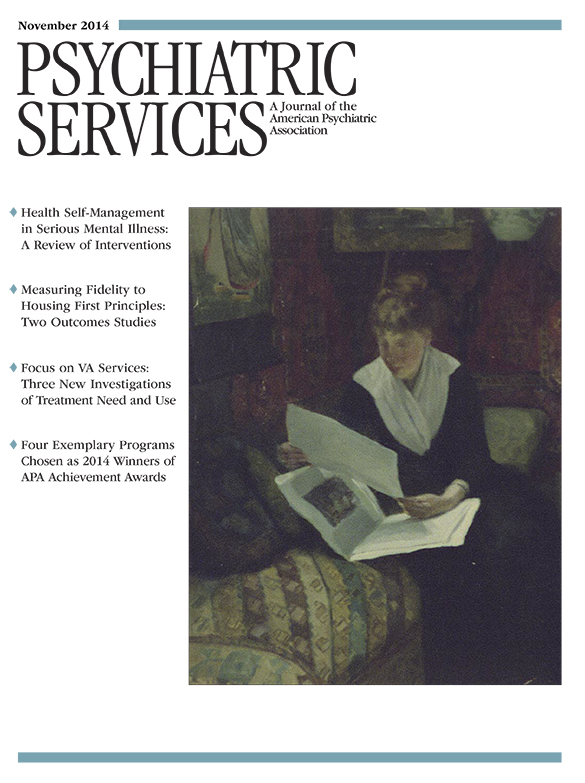Public health concerns about the safety and overuse of antipsychotics are increasing. The American Psychiatric Association recently released recommendations for physicians and patients cautioning against use of antipsychotics without an appropriate initial evaluation and ongoing monitoring; use of two or more antipsychotics concurrently; and use of antipsychotics as a first-line intervention in dementia or insomnia or for children in the absence of a psychotic disorder or other first-line indication (
1). State Medicaid programs, the largest funders of mental health services nationwide, face federal mandates to monitor antipsychotic prescribing. The Child and Family Services Improvement and Innovation Act of 2011 requires states to oversee psychotropic use for foster care youths, in part due to higher use of antipsychotics in this population. The new schizophrenia HEDIS measures relate to antipsychotic use for adults, and Medicare introduced two new antipsychotic quality measures on the Nursing Home Compare Web site in 2012. These developments highlight national concerns about antipsychotic use across age groups, and require states to increase quality management of prescribing practices.
Effective quality improvement (QI) in Medicaid requires databases that integrate pharmacy, behavioral health, and general medical services data, along with well-defined measures, reporting tools that track prescribing practices across and within states, and evidence-based interventions. The Institute of Medicine has promoted the concept of “learning health systems,” in which health care decisions at all levels are based on evidence, stakeholders are engaged, QI and monitoring are iterative and transparent, and data are used to drive policy decision making (
2). Unfortunately, states often lack the tools and capacity to manage quality for mental health service users. Barriers to the development of a learning mental health system are created by fragmentation of service delivery, patient health information, and accountability among state agencies and programs; diversity of funding mechanisms; and lack of well-defined measures for quality management and value-based contracting. Development of measurement-driven QI initiatives bridging these fragmented systems is a complex technical task that can benefit from sustained collaboration between policy makers and academics and between states.
Here we describe the Medicaid/Mental Health Network for Evidence-Based Treatment (MEDNET), the first multistate Medicaid QI collaborative to focus on improving psychotropic prescribing. We—the MEDNET academic coordinating team—share challenges, lessons learned, and early outcomes.
Development and structure
MEDNET builds on partnerships developed during the Medicaid Medical Directors Learning Network Antipsychotics in Children Project, in which 16 participating states examined trends in antipsychotic use among Medicaid-enrolled children (2004–2007) (
3). MEDNET (2010–2013) extended this work with four aims: develop fully specified quality measures for antipsychotic prescribing for children and adults and create a common data platform for analysis, convene a multistate QI consortium and provide a model of stakeholder-informed QI, support states in developing and implementing stakeholder-informed state QI plans to improve performance on the measures, and disseminate information on MEDNET activities and outcomes. The six participating states—Washington, Missouri, California (focusing on Orange County), Maine, Oklahoma, and Texas—had a total of about 20 million Medicaid enrollees in 2010 (
4) and represented a diversity of geographic regions, patient populations, delivery systems, and policy and regulatory environments.
Rutgers University Center for Health Services Research on Pharmacotherapy, Chronic Disease Management, and Outcomes, the academic coordinating center for the project, built a team (the authors) to manage the QI consortium, support data management and analysis, and provide technical assistance (TA) to states. AcademyHealth provided logistical support.
The Rutgers Center created a security remote-access facility (SRAF) to make cleaned and deidentified state-supplied Medicaid data available to states and academic partners. State-supplied Medicaid data were converted into a common data framework, and Rutgers created benchmarking reports for states. A biweekly metrics workgroup of academic and state data experts developed consensus-driven antipsychotic measures. Participating states received the final measurement specifications, statistical (SAS) code for programming the measures, and TA on use of the MEDNET metrics.
States participated in the project steering committee, ensuring that decisions were founded on state priorities. Each state developed a stakeholder-driven QI plan, identifying the target population, partners, MEDNET measures targeted (
5,
6), and strategies to improve performance. States submitted monthly updates on QI milestones and, in monthly multistate meetings, shared challenges and progress on their QI plan, discussing questions and options with expert consultants and their peers.
Each state received customized TA through individual monthly QI calls, annual site visits, and individual expert consultations. We (MEDNET academic coordinating team) provided consultation on best practices in psychotropic prescribing, Medicaid data analysis and quality measure development, quality collaboratives, and measurement-driven QI implementation. We arranged additional outside expert consultation in response to state requests.
Challenges and lessons learned
Measure development and adoption
Analytic strategies and use of performance metrics unexpectedly became a primary TA focus. In some states, a preexisting measure created a barrier to adopting a similar but different MEDNET measure—for example, a state measure of antipsychotic polypharmacy that did not require concurrent use. In the course of implementing the state QI plan, physician feedback led the state to change its preexisting measure to align with the validated MEDNET approach (that is, >90 days concurrent use of two or more antipsychotics to reduce false positives) (
7).
Data access, use, and sharing
State Medicaid data releases to MEDNET involved negotiation of specific data use agreements, business associate agreements, and human subjects approvals; coordination across state agencies; and persistent effort from the MEDNET state representative and the academic coordinating center. This goal was ultimately realized for all participants, but it took longer than anticipated (one to three years), requiring workarounds until state data were available. Sustaining and expanding data-sharing agreements were easier, which highlights the importance of maintaining these relationships once they are established.
MEDNET states were also encouraged to share patients’ Medicaid data with treating providers to target QI efforts. In some cases, states interpreted federal or state laws as prohibiting sharing of data in ways necessary to support QI, including sharing with treating providers, other state health agencies, or medical managed care plans with a behavioral health carve-out. TA involved convening cross-agency work groups, introducing external experts who were able to share precedents and strategies used in other states, and aligning with national fiscal incentives to integrate general medical and mental health, such as health homes.
Value of state-to-state collaboration
States saw value in each other’s ideas, tools, and policy innovations. The initial MEDNET measures were built on the Psychiatric Services and Clinical Knowledge Enhancement System (PSYCKES) measures and Web-based applications developed in New York State, and some states used resources developed by the PSYCKES team (
8,
9). Several states elected to use TA resources to visit model programs in other states or to have another state’s program leaders provide consultation.
State leadership and champions
MEDNET was launched in the context of a national economic recession, a few months before the 2010 gubernatorial elections, resulting in changes in state leadership and priorities. Creative adaptation was necessary in each state to move the project forward. In two states, the state mental health authority was eliminated, as was as the role of the medical directors serving as MEDNET point persons. MEDNET was able to retain these former leaders through consulting contracts, keeping key champions and states involved. For example, the MEDNET point person in one state engaged a county managed care organization in the project in year 1, while ongoing parallel efforts to engage new state health leaders were successful by year 3. Stakeholder engagement and clinical champions are critical not only to carry the project forward but also to establish and sustain the infrastructure needed to deliver useful Medicaid-derived clinical and QI information to prescribers.
Evidence of success
Aim 1: develop antipsychotic measures and a common Medicaid data platform.
Nine measures were developed by the MEDNET consortium and have generated national interest (
5,
6). Several were adapted by the National Collaborative for Innovation in Quality Measurement under the Pediatric Quality Measures Program of the Agency for Healthcare Research and Quality (AHRQ) (
10) and subsequently approved as 2015 HEDIS measures. Several states incorporated MEDNET measures to support federally mandated monitoring of psychotropics for foster care youths. The common Medicaid data platform was established, and several states have committed to ongoing data-sharing agreements after the end of the funded project.
Aims 2 and 3: convene a multistate QI consortium and support implementation of state QI plans to improve performance.
The multistate consortium retained the six participating states despite significant challenges. Each participating state successfully developed and implemented a QI plan. Although data are not yet available on the impact of state projects, several indications suggest that the MEDNET project has accelerated state Medicaid-focused QI efforts. States have incorporated new MEDNET-based Medicaid administrative processes, including integration into standing drug utilization review protocols, a state external quality review organization, and managed care uptake, implementing new QI approaches, and using Medicaid data in new ways to foster learning health care systems.
Aim 4: disseminate information on MEDNET activities and outcomes.
We worked with the Administration on Children, Youth, and Families (ACYF) to disseminate lessons learned to state foster care programs. Two authors (SN-T and SC) served on the ACYF Future Directions work group and consulted on the Because Minds Matter summit (
11), where several MEDNET states presented. Two authors (SB and SC) and ACYF cosponsored a follow-up Data Speaks national workshop (
5). The MEDNET data platform has provided a foundation for new public-academic partnerships, and two additional states became MEDNET affiliates (Ohio and Wisconsin).
Conclusions
MEDNET is the first multistate Medicaid QI collaborative to focus on psychotropic medications and to engage states in development and implementation of consensus-driven, standardized measurement strategies to improve prescribing practices. The project has met its aims of developing fully defined quality measures in collaboration with states, supporting states in the development and implementation of a state QI plan to improve performance on these measures and disseminating lessons learned to other states. States and the MEDNET academic coordinating team have engaged in developing strategies for continuation after the grant period, including sustaining Medicaid data-sharing agreements, and developing new quality collaborative projects that build on the expertise and relationships of the existing network. Finally, MEDNET was funded through AHRQ comparative effectiveness research grants and funds from the American Recovery and Reinvestment Act. Resources that specifically target public-academic partnerships are necessary to support and sustain state efforts to build a learning mental health system for improved delivery of care for patients whose care is publicly funded.
Acknowledgments and disclosures
This work was supported by grant R18 HSO19937 from AHRQ, with additional support from AHRQ grant U19HS021112.
Dr. Finnerty has been the principal investigator on research grants supported by BMS Foundation and Sunovion; her time on these projects was supported in full by the New York State Office of Mental Health. The other authors report no competing interests.

